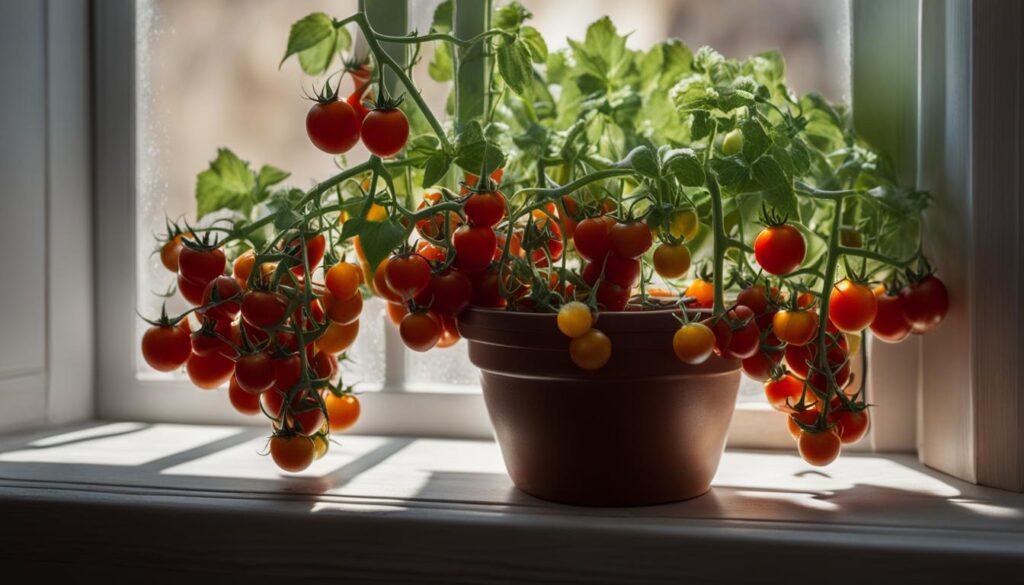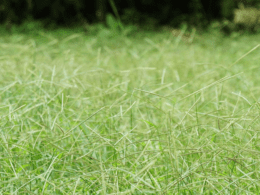Cherry tomatoes are a popular choice for home gardeners, but what if you don’t have a sunny spot in your garden? Can cherry tomatoes grow in shade? The answer might surprise you.
While most tomato plants require full sun to thrive, cherry tomatoes are more adaptable. They can tolerate partial shade or even full shade, making them a great option for gardens with limited sunlight. In fact, with just four to five hours of direct sunlight each day, cherry tomatoes can still produce reasonable yields.
There are even some heirloom varieties, like Black Krim, that actually perform better when grown in partial shade. However, it’s important to keep in mind that tomatoes grown in shade may have a lower yield and slower fruit ripening compared to those grown in full sun.
Post Summary
- Cherry tomatoes can tolerate partial shade or full shade.
- With four to five hours of direct sunlight each day, they can still produce reasonable yields.
- Some heirloom varieties, like Black Krim, perform well in partial shade.
- Tomatoes grown in shade may have a lower yield and slower fruit ripening.
- Proper care, including adequate sunlight, nutrients, and airflow, is crucial for maximizing growth and yield in shady conditions.
How Much Sun Do Tomatoes Need To Grow?
When it comes to growing tomatoes, the amount of sun they receive is crucial for their growth and development. While cherry tomatoes are known to be more shade-tolerant compared to other tomato varieties, they still require a certain amount of direct sunlight to thrive.
Regular tomato plants, whether determinate or indeterminate, generally need at least six hours of direct sunlight per day. This ensures they receive enough energy to produce healthy foliage, promote growth, and yield abundant fruits. In fact, providing more than six hours of sunlight can be beneficial for tomato plants as it enhances their overall productivity.
However, it’s important to consider the climate as well. In hot climates, it may be necessary to provide some shade during the hottest parts of the day to prevent leaf and fruit scorching. This can be achieved by using shade cloths or strategically placing the plants in areas with partial shade.
Factors Affecting Sunlight Needs for Tomato Plants
Several factors can influence the sunlight needs of tomato plants. These include:
- The specific tomato variety being grown
- The local climate and temperature
- The placement of the plants in the garden or container
- The use of shade cloths or other shading methods
By understanding these factors and providing the appropriate amount of sunlight, you can ensure the successful growth of your tomato plants and enjoy a bountiful harvest.
Tomato Varieties That Grow Well in Shade
Not all tomatoes require full sun to produce tasty fruits. Some varieties, especially cherry tomatoes, are less sensitive to shady conditions. As long as they receive four to five hours of direct sunlight each day, they can still produce reasonable yields. Additionally, heirloom varieties like Black Cherry, Roma, Siberia, and Black Krim are known to perform well in partial shade. It’s important to choose shade-tolerant tomato varieties for successful growth in shady areas.
When it comes to growing tomatoes in shade, selecting the right varieties is key. Shade-tolerant tomatoes have adapted to lower light conditions and are more likely to thrive in shady areas. Cherry tomato varieties like Black Cherry are renowned for their ability to handle partial shade while still producing flavorful fruits. Roma tomatoes, with their compact growth habit, are also a great choice for growing in shady spots. Siberia tomatoes, known for their cold tolerance, can handle both shade and cooler temperatures, making them an ideal option for shady areas with milder climates. Lastly, the Black Krim tomato, with its rich and smoky flavor, is an heirloom variety that performs exceptionally well in partial shade.
While cherry tomatoes are the most shade-tolerant variety, other types, such as beefsteak or slicing tomatoes, may struggle in low-light conditions. It’s important to consider the specific needs of each tomato variety and choose accordingly. By selecting shade-tolerant varieties, you can ensure a successful harvest even in areas with limited sunlight. Experimenting with different tomato varieties and paying attention to their shade tolerance can lead to a bountiful harvest, regardless of the amount of sunlight available in your garden.
| Tomato Variety | Sunlight Requirements | Benefits |
|---|---|---|
| Black Cherry | 4-5 hours of direct sunlight | Handles partial shade well, produces flavorful fruits |
| Roma | 4-5 hours of direct sunlight | Compact growth habit, suitable for growing in shady spots |
| Siberia | 4-5 hours of direct sunlight | Cold-tolerant, can handle shade and cooler temperatures |
| Black Krim | 4-5 hours of direct sunlight | Heirloom variety, performs well in partial shade, rich and smoky flavor |
Shade-Tolerant Tomato Varieties
Tips for Growing Tomatoes in Shade
When it comes to growing tomatoes in partial shade, there are a few key tips to keep in mind to ensure successful gardening. By following these guidelines, you can maximize the growth and yield of your tomato plants, even in less-than-ideal lighting conditions.
Choose Shade-Tolerant Varieties
One of the most important factors to consider when growing tomatoes in shade is selecting the right variety. Opt for shade-tolerant tomato varieties like Black Cherry or Roma, which are known to perform well in partial shade. These varieties have adapted to thrive in lower light conditions and can still produce reasonable yields with four to five hours of direct sunlight each day.
Consider Placement and Spacing
The placement of your tomato plants in the garden is crucial for their growth. Choose spots that receive morning sun and filtered or light shade during the rest of the day. Avoid planting tomatoes next to walls facing north or under dense tree canopies, as these areas may have limited sunlight throughout the day. Additionally, proper spacing is essential to ensure adequate airflow around the plants, reducing the risk of disease and promoting healthy growth.
Provide Adequate Nutrients and Water
Tomato plants grown in shade may require extra care and attention to meet their nutrient and water needs. Make sure to provide a balanced fertilizer specifically formulated for tomatoes, and follow the recommended application rates. Regularly monitor the moisture levels in the soil and water the plants as needed, aiming for consistent moisture without overwatering. Well-draining soil is essential to prevent waterlogged roots, which can lead to root diseases.
Pruning and Airflow
To further enhance the growth and health of your shade-grown tomatoes, consider implementing proper pruning techniques. Remove any suckers that develop between the main stem and branches to allow better airflow and light penetration. This helps reduce the risk of disease and promotes faster drying of leaves and soil. Additionally, creating airflow channels by spacing the plants and removing any overcrowded foliage can further aid in preventing fungal diseases.
| Tip | Description |
|---|---|
| Choose Shade-Tolerant Varieties | Select tomato varieties known to perform well in partial shade, such as Black Cherry or Roma. |
| Consider Placement and Spacing | Plant tomatoes in areas that receive morning sun and light shade during the rest of the day. Proper spacing allows for adequate airflow. |
| Provide Adequate Nutrients and Water | Use a balanced fertilizer for tomatoes and monitor soil moisture levels to provide necessary nutrients and water. |
| Pruning and Airflow | Remove suckers and overcrowded foliage to promote airflow and prevent the onset of diseases. |
Other Considerations for Growing Tomatoes in Shade
When it comes to growing tomatoes in shade, there are a few additional factors to consider to ensure successful growth and maximize your yield. While tomatoes grown in shade may not produce as abundantly or ripen as quickly as those grown in full sun, selecting the right tomato varieties and implementing proper care techniques can help mitigate these challenges.
Tomato Varieties for Less Sun Exposure
Choosing tomato varieties that are specifically bred for less sun exposure is key when growing tomatoes in shade. Smaller varieties like cherry tomatoes tend to handle limited sunlight better than larger varieties. Some recommended options include Gardener’s Delight, Sweet 100, and Yellow Pear. These varieties have shorter maturity dates and can still produce tasty fruits even with minimal sun exposure.
Tomatoes with Shorter Maturity Dates
Tomato varieties with shorter maturity dates are ideal for growing in shade. These varieties typically require less time to reach maturity and ripen their fruits. Early Girl, Celebrity, and Fourth of July are examples of tomatoes with shorter maturity dates. By choosing these varieties, you can increase your chances of successfully growing tomatoes in shade, even with limited sunlight.
The Importance of Proper Care
Proper care is crucial for tomatoes grown in shade to overcome the challenges posed by limited sunlight. Ensure that your tomato plants receive adequate nutrients by fertilizing them regularly. Water the plants consistently, avoiding both overwatering and underwatering. Additionally, pay attention to soil drainage and moisture retention to prevent disease susceptibility. Implementing these care practices will help promote healthy growth and increase your chances of a successful harvest.
In conclusion, while growing tomatoes in shade may come with some limitations, it is still possible to achieve satisfactory results by selecting shade-tolerant varieties, prioritizing tomato varieties with shorter maturity dates, and providing proper care. Remember that tomatoes grown in shade may yield fewer fruits and ripen more slowly than those grown in full sun, but with the right approach, you can still enjoy homegrown tomatoes even in shady areas of your garden.
Conclusion
In conclusion, while it is possible to grow cherry tomatoes in shade, it’s important to manage your expectations. These varieties can tolerate partial shade and still produce reasonable yields, but they may not match the productivity or speed of tomato plants grown in full sun.
To maximize your success in growing cherry tomatoes in shade, it is crucial to provide the right conditions. This includes ensuring they receive four to five hours of direct sunlight each day, planting shade-tolerant varieties like Black Cherry and Roma, and carefully selecting the placement of your tomato plants in the garden.
Remember to provide adequate nutrients, water, and airflow to promote healthy plant growth and yield. Additionally, consider factors such as moisture retention, soil drainage, and avoiding overwatering to prevent disease susceptibility in tomatoes grown in shade.
By following these tips and experimenting with different tomato varieties, you can increase your chances of successfully growing cherry tomatoes in shade. While the yields may be lower and the ripening process slower, with proper care and attention, you can still enjoy a bountiful harvest of delicious cherry tomatoes even in shadier areas of your garden.
FAQ
Can cherry tomatoes grow in shade?
Yes, cherry tomatoes are a variety of tomatoes that can tolerate partial shade or even full shade. They can still produce reasonable yields with four to five hours of direct sunlight each day.
How much sun do tomatoes need to grow?
“Regular” tomato plants generally need at least six hours of direct sunlight per day to thrive. More than six hours of sunlight can be beneficial for healthier foliage, faster growth, and better fruit production.
Which tomato varieties grow well in shade?
Some shade-tolerant tomato varieties include Black Cherry, Roma, Siberia, and Black Krim. These varieties are known to perform well in partial shade conditions.
What are some tips for growing tomatoes in shade?
When growing tomatoes in shade, it’s important to choose shade-tolerant varieties, provide adequate nutrients, water, and airflow, and select spots in the garden that receive morning sun and filtered or light shade during the rest of the day. Proper spacing, pruning, and creating airflow channels can also help prevent disease.
What other considerations should I keep in mind when growing tomatoes in shade?
Tomatoes grown in shade may yield fewer fruits and have slower ripening compared to those grown in full sun. It’s advisable to choose smaller varieties like cherry tomatoes and select tomato varieties with shorter maturity dates for better results. Proper care, such as moisture retention, proper soil drainage, and avoiding overwatering, are crucial to avoid disease susceptibility.
Would Green Chili Plants Thrive in Shaded Areas Like Cherry Tomatoes?
Yes, a grow green chili plant can thrive in shaded areas, much like cherry tomatoes. While they prefer full sun, green chili plants can still produce good yields in partial shade. Just make sure they receive at least 6 hours of sunlight to ensure healthy growth and fruit production.










